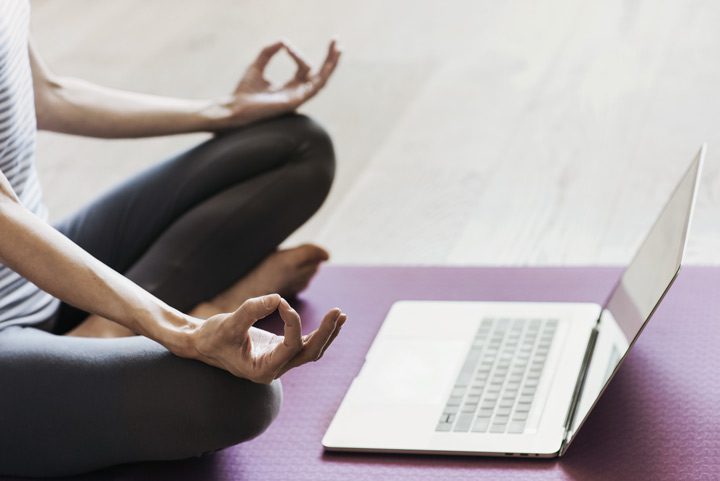
Everyone can benefit from a gentle yoga practice. Making time to move even a little bit each day and focus on your breath prompts many natural healing responses that benefit mind and body. Whether you’re in addiction recovery or learning how to effectively manage mood and mental health disorders, yoga offers many advantages.
Scientific Support for Yoga
It took many years for the scientific community to study and recognize the benefits of yoga. Now, the general consensus is that stretching, breathing, and finding a point of stillness provides individuals with a reset button: a viable tool to reduce their stress response, inflammation, and chaos.
This article from the National Institutes of Health summarizes multiple benefits of yoga, including:
- Creates balance in the central nervous system by moving from the flight-or-fight response to the relaxation response, which reduces blood pressure and cortisol—the stress hormone—and increases circulation
- Helps the immune system stay strong
- Regulates the hypothalamus to provide more emotional stability
- Manages depression and anxiety with natural stimulation of serotonin and cortisol
- Provides chronic pain relief by improving flexibility in the muscles and connective tissues
- Improves resting heart rate, endurance, sleep, circulation, and oxygen flow
- Fosters a relationship between positive wellness habits and better control over health
Even dedicating yourself to practicing yoga for 20 minutes two or three days a week will make a noticeable difference in how you feel and think, and how you process stress.
Many Options for Yoga
From its Eastern origins to the many Western interpretations, there’s a discipline of yoga that fits every personality and belief system.
While yoga isn’t a religion, it can have spiritual applications if that’s what you choose—service to others as a way of expressing devotion to God, for example, is the root of karma yoga. Some individuals enjoy chanting, dancing, singing, and celebration along with their practice, which is the heart of bhakti yoga. Many people delve deep into the ancient yogic philosophies as well as physical movement, which is an extension of jnana yoga. For advanced practitioners, they embrace a combination of all types into raja yoga.
However, most of us experience yoga with a balance of physical postures, known as asanas, and breathwork, called pranayama. Meditation can also be part of a yoga session or practiced separately. There are many styles of yoga practice.
What to Know Before Practicing
Often people say, “I’m not flexible enough to do yoga!” because they’re used to seeing someone in a pose that’s often bendy or twisty—but few adults start off that way! If you’re committed to practicing yoga regularly, consistent movement will absolutely change your flexibility. Embrace the beginner’s mind, recognize that you might need to adjust your expectations a bit, and use props as needed to feel most comfortable.
Yoga should never be painful. However, you might often experience tension in certain areas that releases over time. For example, if you’ve lost some mobility in your shoulders, raising your arms overhead might feel restricted. Use the pose to move into the body and don’t push into the tension: instead, move your arms gently until you feel the restriction, then pause—even if your arms aren’t overhead—and breathe. This might be your posture for quite some time until your body responds to the consistency and opens up. Other areas where people feel initial restriction might include wrists, low back, hips, thighs, and hamstrings.
Breath is vital to practice. Movement without a focus on breath isn’t yoga: it’s aerobics. Better to move less and breathe more if you have to make a choice to be comfortable. The better your breath, the easier it is for your body to extend and your mind to clear. Breath leads movement, so coordinate your inhale with expanding postures, such as opening your arms wide, lifting your chest, and moving into backbends. Align your exhale with lengthening poses, such as bending forward, twisting from side-to-side, and deepening.
Props are helpful extensions. Too often, people will try to touch their toes, hyperextend through the low back while reaching, feel a sharp jab, and give up yoga. But there are many reasons for this: restriction in the muscles or connective tissues of the lower body, differing lengths between the torso/arms and legs, restricted hamstrings if the body is “too cold” to move into this pose yet…any one or all might contribute to this issue. But if an individual rests their hands on stacked blocks instead of reaching for the floor, creating enough height to keep the spine straight and the breath deep, there should be no pain at all!
Here are some props to have handy for a gentle yoga practice:
- A yoga strap, which varies in length, or use a beach towel, long belt, or two neckties linked together. Good for reaching and extending.
- Yoga blocks, which come in many shapes, sizes, and materials, or use a firm couch pillow or a towel wrapped around a large book. Helps support a position or “bring the floor closer to you.”
- A yoga bolster, which can be long or short, depending on your body type, or use two thick blankets folded together in thirds. Great for providing extra lift or expansion.
Get Started With These Videos
It’s more safe and effective to work with a registered yoga instructor if you’re new to yoga, but if time, location, or health reasons prohibit this for now, the following videos should help. Watch them once all the way through before trying so you know what to expect and if props are necessary:
- An easy Chair yoga practice with modifications
- A relaxing Yin yoga sequence
- Seated yoga for the neck, shoulders, and upper back
- A short restorative stretch
- A body positive yoga practice with props
- A comforting sound bath to end whatever session you choose
At Cottonwood Tucson, yoga is just one of the many holistic approaches we use to help people find healing peace. Learn more by entering “yoga” into our blog search to find additional articles.






